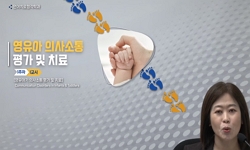배경 및 목적: 자연스러운 상호작용에서 어머니와 영유아가 발성을 주고받는 것은 초기 의사소통 단계에 해당한다. 본 연구는 발성 차례주고받기에서 나타나는 어머니와 인공와우이식 영유...
http://chineseinput.net/에서 pinyin(병음)방식으로 중국어를 변환할 수 있습니다.
변환된 중국어를 복사하여 사용하시면 됩니다.
- 中文 을 입력하시려면 zhongwen을 입력하시고 space를누르시면됩니다.
- 北京 을 입력하시려면 beijing을 입력하시고 space를 누르시면 됩니다.

인공와우이식 영유아와 어머니의 발성 차례주고받기 특성 = Vocal Turn-taking between Mothers and Their Toddlers with Cochlear Implants
한글로보기https://www.riss.kr/link?id=A108547453
- 저자
- 발행기관
- 학술지명
- 권호사항
-
발행연도
2023
-
작성언어
-
- 주제어
-
KDC
370
-
등재정보
SCOPUS,ESCI
-
자료형태
학술저널
- 발행기관 URL
-
수록면
158-169(12쪽)
- 제공처
-
0
상세조회 -
0
다운로드
부가정보
국문 초록 (Abstract)
배경 및 목적: 자연스러운 상호작용에서 어머니와 영유아가 발성을 주고받는 것은 초기 의사소통 단계에 해당한다. 본 연구는 발성 차례주고받기에서 나타나는 어머니와 인공와우이식 영유아의 시간적, 양적 요소들을 살펴보고, 이를 건청 영유아와 어머니의 특성과 비교하였다. 방법: 만 2세 이전에 인공와우이식을 받은 12-36개월 사이의 영유아와 어머니 10쌍, 이들과 생활연령을 일치시킨 건청 영유아와 어머니 12쌍이 참여하였다. 어머니와 영유아는 20분 동안 자유놀이 과제를 진행하였다. 결과: 첫째, 어머니의 발성 빈도는 집단 간에 유의한 차이가 없었으나, 영유아의 발성 빈도는 집단 간에 유의한 차이가 있었다. 둘째, 어머니와 영유아간 상호작용에서 발성 차례주고받기 빈도는 집단 간에 유의한 차이가 있었다. 셋째, 발성 차례주고받기에 나타난 어머니의 발성 비율은 집단 간에 유의한 차이가 있었으며, 영유아의 발성 비율은 집단 간에 유의한 차이가 없었다. 넷째, 인공와우이식 영유아의 수용 및 표현언어 점수는 발성 차례주고받기 빈도, 영유아의 발성 빈도, 어머니의 차례주고받기에 나타난 발성 비율과 유의한 정적 상관이 있었다. 논의 및 결론: 본 연구는 인공와우이식 영유아가 건청 영유아에 비하여 어머니 발성에 적게 응답하며, 인공와우이식 영유아의 어머니가 건청 영유아 어머니에 비하여 응답 받지 못하는 발성이 많기에, 인공와우이식 집단의 발성 차례주고받기가 비효율적이라는 점을 시사한다. 본 연구는 인공와우이식 영유아와 어머니의 효율적인 의사소통을 위하여 영유아뿐만 아니라 어머니를 대상으로 한 적절한 중재가 제공되어야 함을 시사한다.
다국어 초록 (Multilingual Abstract)
Objectives: This study attempted to identify the quantitative characteristics that appear in vocal turn-taking between mothers and toddlers with cochlear implants (CIs) and to examine the relationships between variables of vocal turn-taking and the la...
Objectives: This study attempted to identify the quantitative characteristics that appear in vocal turn-taking between mothers and toddlers with cochlear implants (CIs) and to examine the relationships between variables of vocal turn-taking and the language development of the CI and typical hearing (TH) group. Methods: Ten pairs of mothers and toddlers with CIs and 12 pairs of mothers and toddlers with TH participated in this study. Their interactions during a 20-minute free-play task were recorded using a digital recorder. Their vocalizations were coded for vocalization, switching pause, turn-taking block, and overlap using the Praat program. Results: Toddlers with TH took more vocal turns with their mothers than did toddlers with CIs. Toddlers with TH produced significantly more vocalizations than toddlers with CIs; however, there was not a significant difference in the frequency of mothers’ vocalizations between the two groups. Mothers in the TH group produced a significantly highter proportion of vocalizations in turn-taking than mothers in the CI group; however, there was not a significant difference in the proportion of toddlers’ vocalizations between the two groups. Language scores were significantly correlated with the frequency of vocal turn-taking, toddlers’ vocalizations, and mothers’ vocalizations in the CI group. Conclusion: These results suggests that toddlers with CIs are not active partners in vocal turn-taking at an earlier age and that mothers are likely to adjust vocal turn-taking formats to their toddlers with CIs. The variables of vocal turn-taking can be a sensitive index to predict language skills in the CI group.
동일학술지(권/호) 다른 논문
-
디지털 치료제 개발을 위한 자폐스펙트럼장애 아동 부모교육 프로그램의 효과
- 한국언어청각임상학회
- 정필연(Pil Yeon Jeong)
- 2023
- SCOPUS,ESCI
-
고기능 자폐범주성장애 집단의 아이러니 이해에 대한 메타분석
- 한국언어청각임상학회
- 최윤정(Younjung Choi)
- 2023
- SCOPUS,ESCI
-
학령기 아동의 이야기 전사를 위한 자동음성인식 프로그램 비교
- 한국언어청각임상학회
- 양희재(Hui Jae Yang)
- 2023
- SCOPUS,ESCI
-
과제 유형(읽기, 쓰기)에 따른 난독아동의 음운변동 오류 특성
- 한국언어청각임상학회
- 전예지(Ye Ji Jeon)
- 2023
- SCOPUS,ESCI




 스콜라
스콜라


